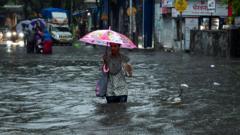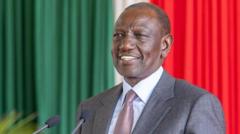The push for compressed natural gas in Tanzania is fraught with obstacles, as limited filling stations lead to long queues and frustration among motorists. Despite the potential for cost savings and environmental benefits, infrastructure developments lag behind the growing demand, leaving many aspiring CNG users waiting for better access.
Tanzania's CNG Transition Faces Hurdles with Limited Infrastructure

Tanzania's CNG Transition Faces Hurdles with Limited Infrastructure
As Tanzania warms up to compressed natural gas, a shortage of filling stations poses challenges for early adopters.
Tanzania is experiencing a burgeoning shift towards compressed natural gas (CNG) as an alternative fuel, but the revolution is hindered by a critical shortage of filling stations. Following the trend set by Nigeria and other African nations, the government's push for CNG is driven by its cleaner profile and impressive cost efficiency, especially appealing to commercial drivers in the country.
Although only around 5,000 drivers have made the switch to CNG, the government eyes a future where the majority of vehicles will rely on this resource. With significant gas reserves off its coast, Tanzania presents a potentially lucrative and environmentally friendly energy solution. Taxi driver Samuel Amos Irube demonstrates the shift; spending approximately 1.5 million Tanzanian shillings (about $620) to convert his bajaji to CNG, he saves approximately 60% on fuel costs. However, refueling presents another story altogether, with only four stations serving the commercial hub of Dar es Salaam, which often results in long wait times.
Motorists like Medadi Kichungo Ngoma express their frustration over the inadequate infrastructure, recalling a time when refueling was swift and efficient. Despite the orderly lines, the reality of lengthy waits—up to three hours—counters any praise for the financial benefits of switching to CNG. Sadiki Christian Mkumbuka, who also waits three hours for his turn at the pump, echoes the sentiment for increased infrastructure, lamenting the disparity between CNG and petrol filling stations.
Though the initiative to boost CNG adoption dates back over a decade, true momentum only gained traction in 2018, catching authorities off guard with the explosion in demand. Aristides Kato, the project manager at the Tanzania Petroleum Development Corporation (TPDC), acknowledged the shortfall in infrastructure due to rapid uptake by vehicle owners.
Despite these hiccups, the long-term vision for CNG is clear: offering a cleaner-burning fossil fuel with lower emissions. Initially, the cost of vehicle conversion alongside the lesser mileage of CNG has deterred some drivers, but more positions are emerging in support of this transition. Amr Aboushady from Taqa Arabia highlights an optimistic outlook on expanding filling stations, inspired by Egypt’s successful CNG story.
The Tanzanian government remains focused on combating the infrastructure obstacles, announcing a centralized CNG 'mother station' set for construction in Dar es Salaam, coupled with plans for mobile CNG units accessing multiple urban areas. Although these developments promise relief, the immediate future holds lengthy queues and frustrations for early CNG adopters, as they navigate a fuel revolution constrained by a lack of access.




















